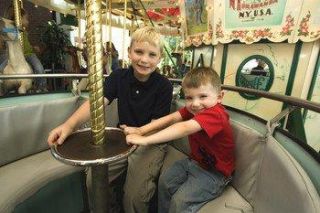Relationships
Giving It a Whirl in the Love Tub
There’s a last time for everything.
Posted May 22, 2013
I remember the very day that I took my last spin in a crowded “love tub.” I know it sounds like something Barry White would sing about—“the luvvvvv tub, oh Baby”—but hang on. If you’re conjuring the image of a convivial, California, coed, adult splash, you can stop with the fantasizing already. This love tub, also called a spinning tub, is a popular feature of a historic 1918 carousel installed at the National Museum of Play at The Strong (the interesting place where I work).

Elaine Wilson Carousel at the National Museum of Play
With plunging roller coasters nowadays carrying names like, “The Raptor,” “The Corkscrew,” “Freefall,” and “Magnum Force,” the carousel may seem to belong to another era. But at the beginning of the last century, carousels at amusement parks and boardwalks offered riders high-end thrills. Ride a bucking carved and painted horse that describes the tight curve on a carousel platform, and you’ll still have some fun. Even a century later, you can’t make your car turn this fast. But some carousels come equipped with a love tub that much enhances the thrills that the ride has to offer. How much fun you’ll have in the love tub will depend upon how many summers you’ve seen. And the dizziness some feel is part of an age-old-story (and an old-age story) about how play changes over time.
First a little physics and then some thoughts about play. The spinning tub, a round enclosed platform with seats, features a wheel that connects with an axle that allows riders to turn the freewheeling tub clockwise or counterclockwise, and fast or slow, as the merry-go-round itself revolves. So, rotating within a revolution or against it, the spinning tub describes a spiral in a circle that rhythmically accelerates g-forces for its squealing passengers. The spin tries to throw riders off at a tangent, repeatedly crunching them together, and rhythmically pulling them apart— cathumpp, caschwingg. And that’s significant because, in the late 19th century, when Victorian mores prevailed for middle class people, the love tub squished couples close, obliging physical contact in full public view, but in a playful context. It’s a bit hard now to believe how proximity this prim and fleeting could have offered a romantic thrill that would otherwise lie well beyond propriety. But when it comes to affairs of heart, context is everything.
The appeal of the spinning tub also works at another more basic and timeless physical and psychological level. Kids will whirl like dervishes because they register dizziness as pleasure. To disturb the vestibular system and collapse in a heap with the world still turning is one of the distinct pleasures of childhood. Swings and seesaws offer a variety of this delight. Adults sample some of the same feeling when they dance or ski, but notice how an element of control creeps in. As adults we rarely abandon ourselves voluntarily to vertigo. And then at some point, note how we adults begin to avoid the giddy and the queasy feeling altogether. I love roller coasters, however. A few years ago I had to try the towering coaster The Mean Streak reputed to be the tallest wooden roller coaster in the world. Purposely rickety and old-fashioned in contrast to the modern smooth rides, this punishing contraption leaves the thrill-seeker feeling beat up. I noticed two things when I disembarked The Mean Streak, not a single passenger was smiling; also, and by a long stretch, I was the only one with grey hair. Like a few others that day, I vowed never to do that again.
One of the great scholars of “ludology,” the celebrated French intellectual Roger Caillois, divided play into four fundamental realms: agon or competition (think chess or tennis), alea—chance (think the lotto), mimicry (all the pretending and roll-playing that lies at the heart of games fit this category), and ilinx—a word he borrowed from Greek meaning “whirlpool.” To imagine ilinx, think roller coaster riding and skateboarding and stunt-flying and ski-jumping. Think cliff diving and bungee jumping. Play teaches one of life’s lessons, that we should seize the day. I’ve passed the love tub by too many times. We delight by playing in the whirlpool when we’re young, but at some point for most, even the love tub leans toward motion sickness.


